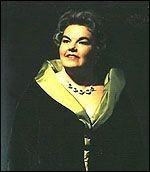
Eileen Farrell |
Eileen Farrell

Although her career at the top of the operatic Olympus was relatively short-lived, Eileen Farrell is considered by many to be one of the leading dramatic sopranos of her time. The singer had a happy fate in her relationship with the recording industry: she recorded a number of solo projects (including “light” music), participated in the recordings of entire operas, which were a great success.
Once a music critic for the New York Post (in the 1966 season) spoke of Farrell’s voice in the following enthusiastic terms: “[her voice] … sounded like a trumpet voice, as if the fiery angel Gabriel appeared to herald the coming of the new millennium.”
In fact, she was an unusual opera diva in many ways. And not only because she felt free in such opposite musical elements as opera, jazz, and popular songs, but also in the sense that she led an absolutely ordinary life style of a simple person, and not a prima donna. She married a New York policeman, and calmly refused contracts if she had to perform far from her family – her husband, son and daughter.
Eileen Farrell was born in Willimantic, Connecticut, in 1920. Her parents were vaudeville singer-actors. Eileen’s early musical talent led her to become a regular radio performer by the age of 20. One of her admirers was her future husband.
Already well known to a wider audience through radio and television appearances, Eileen Farrell made her debut on the San Francisco opera stage in 1956 (the title role in Cherubini’s Medea).
Rudolf Bing, CEO of the Metropolitan Opera, did not like the singers he invited to the Met to have their first success outside the walls of the theater under his charge, but, in the end, he invited Farrell (she was then already 40 years old) to stage “ Alceste” by Handel in 1960.
In 1962, the singer opened the season at the Met as Maddalena in Giordano’s André Chénier. Her partner was Robert Merrill. Farrell appeared at the Met in six roles over five seasons (45 performances in total), and said goodbye to the theater in March 1966, again as Maddalena. Years later, the singer admitted that she constantly felt pressure from Bing. However, she was not touched by such a late debut on the famous stage: “All this time I was completely loaded with work either on radio or on television, plus concerts and endless sessions in recording studios.”
The artist was also a favorite New York Philharmonic season ticket soloist, and singled out Maestro Leonard Bernstein as her favorite conductor of those with whom she had to work. One of their most notorious collaborations was a 1970 concert performance of excerpts from Wagner’s Tristan und Isolde, in which Farrell sang a duet with tenor Jess Thomas (a recording from that evening was released on CD in 2000. )
Her breakthrough into the world of pop music came in 1959 during her performances at the festival in Spoleto (Italy). She gave a concert of classical arias, then took part in the performance of Verdi’s Requiem, and a couple of days later, she replaced the ill Louis Armstrong, performing ballads and blues in a concert with his orchestra. This striking 180-degree turn created a sensation in the public at the time. Immediately upon her return to New York, one of the Columbia Records producers, who had heard jazz ballads performed by the soprano, signed her to record them. Her hit albums include “I’ve Got a Right To Sing the Blues” and “Here I Go Again.”
Unlike other opera singers who tried to cross the line of the classics, Farrell sounds like a good pop singer who understands the context of the lyrics.
“You have to be born with it. Either it comes out or not, ”she commented on her success in the“ light ”sphere. Farrell tried to formulate the canons of interpretation in her memoir Can’t Stop Singing – phrasing, rhythmic freedom and flexibility, the ability to tell an entire story in one song.
In the career of the singer, there was an episodic connection with Hollywood. Her voice was voiced by actress Eleanor Parker in the film adaptation of the life story of opera star Marjorie Lawrence, Interrupted Melody (1955).
Throughout the 1970s, Farrell taught vocals at Indiana State University, continuing to play shows until an injured knee ended her touring career. She moved with her husband in 1980 to live in Main and buried him six years later.
Although Farrell said she didn’t want to sing after her husband’s death, she was persuaded to continue recording popular CDs for several more years.
“I figured that I kept part of my voice. Taking notes, therefore, would be an easy job for me. This shows what a dumbass I was, because in fact it turned out to be not at all easy! Eileen Farrell sneered. – “And, nevertheless, I am grateful to fate that I can still sing at such an age as mine” …
Elizabeth Kennedy. Associated Press Agency. Abridged translation from English by K. Gorodetsky.





